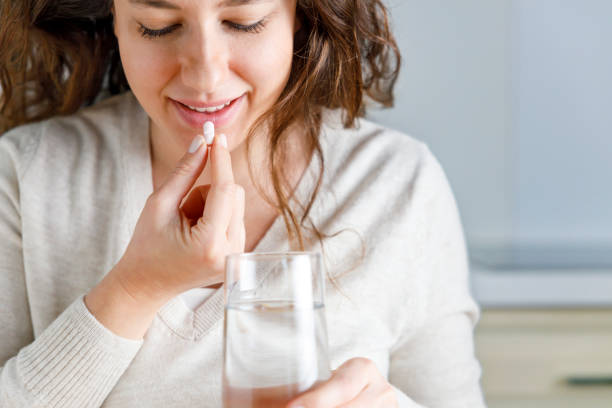Have you ever experienced the “winter blues”? Many individuals attribute a low mood during fall or winter to limited sunlight exposure. However, some experience a more serious condition known as seasonal affective disorder (SAD), a recurring form of depression that impacts thinking, mood, and behavior. It seems the further an individual resides from the equator, the greater likelihood of being affected by seasonal affective disorder. In temperate climates, such as the United States and Canada, seasonal affective disorder affects one to three percent of individuals. (6)
Continue reading to learn more about SAD and seasonal affective disorder and integrative treatments for the condition.
What is seasonal affective disorder?
Seasonal affective disorder (SAD) is a form of depression that recurs with a seasonal pattern, most commonly in the fall and winter months. Onset of the condition typically occurs between 18 and 30 years of age. SAD is characterized by depressive symptoms, such as feelings of sadness, mood swings, low energy, social withdrawal, and a decrease in activity levels. SAD is believed to be a result of a reduced exposure to sunlight and the reduced hours of daylight during fall and winter months. (8)
Understanding the mechanisms behind seasonal affective disorder
Researchers are still working to understand all of the mechanisms behind SAD. (6) However, several of the proposed mechanisms include:
- An overproduction of melatonin, a hormone that induces sleepiness
- Changes in vitamin D production
- Difficulty regulating serotonin, a neurotransmitter involved in balancing mood
- Irregular circadian rhythm (internal daily clock) responses to seasonal time changes (8)
Causes and risk factors of seasonal affective disorder
The factors contributing to SAD include:- Age: adults under 50 years of age are more at risk (1)
- Gender: females are diagnosed with SAD four times more often than males (6)
- Genetic predisposition: individuals with a family history of SAD, depression, or bipolar disorder (8)
- Geographical location: living farther from the equator increases risk (8)
- Having depression or bipolar disorder: symptoms in individuals with these conditions may be more severe seasonally (9)
- Shift work or altered schedules that limit sunlight exposure (8)

Seasonal affective disorder symptoms
Seasonal affective disorder symptoms may vary from mild, known as subsyndromal SAD (S-SAD) or the “winter blues”, to severe, which can impact an individual’s ability to function normally. (8) Seasonal affective disorder symptoms are similar to those of major depressive disorder and include:- Agitation or irritability
- Carbohydrate and sugar cravings
- Changes in appetite or weight
- Feelings of depression, hopelessness or worthlessness
- Frequent thoughts of death or suicide
- Loss of interest in regular activities
- Low energy and being lethargic
- Sleep problems or excessive sleep
- Trouble concentrating (8)(9)
Seasonal affective disorder treatments
Emerging research has demonstrated the effectiveness of certain therapies as seasonal affective disorder treatments, including light therapy and cognitive behavioral therapy. (3)(11) Additionally, focusing on improving lifestyle habits and supplementing with vitamin D or St. John’s wort when directed by a healthcare practitioner may be beneficial. (8)(14) Learn about what you can do to address or decrease your risk of SAD.Light therapy
Seasonal affective disorder light therapy is a common SAD treatment which involves daytime exposure to a lamp that emits white light to simulate exposure to sunlight. A meta-analysis of randomized, controlled trials found that the effectiveness of seasonal affective disorder light therapy was comparable to trials of antidepressant medication. Research has demonstrated both 2,500-lux white light for two hours per day and 10,000-lux for 30 minutes per day to be effective. (3)Cognitive behavioral therapy
Cognitive behavioral therapy (CBT) adapted for SAD has been shown to improve depressive symptoms. CBT aims to change an individual’s perspective and negative thought patterns. (8) A study that followed patients with SAD for two winters examined the effects of light therapy or CBT. The study found that while the treatment outcomes were comparable during the first winter, the CBT group experienced fewer recurrences and less severe seasonal affective disorder symptoms during the second winter. (11)Vitamin D supplementation
Low levels of vitamin D have been associated with depression and SAD. Vitamin D status is assessed by a blood test, with 30 nq/mL 25-hydroxyvitamin D (25-OH D) considered to be optimal. (8) While larger trials are needed, preliminary research in individuals with SAD suggests that vitamin D supplementation and improved 25-OH D levels are associated with more favorable depression scale scores. (2)St. John’s wort supplementation
St. John’s wort (Hypericum perforatum), a medicinal herb known for its effectiveness in treating depression, may also improve seasonal affective disorder symptoms. Studies have found supplementing with St. John’s wort to be as effective as light therapy for SAD. (14)
Sunlight exposure
Spending more time outside and letting more natural light into your home can help increase your exposure to sunlight, another form of seasonal affective disorder light therapy. A review study found that both ultraviolet (UV) exposure to the skin and UV exposure to the eyes have a positive effect on depression scores. (13) Research also found that exposing individuals with SAD to bright light with UV light was associated with reduced scores in three rating systems of depression, compared to UV-blocked bright light, which was associated with reduced scores in only one rating system. (4) Keep in mind that excessive sun exposure increases the risk of skin cancer. The Skin Cancer Foundation recommends minimizing time outdoors during peak hours (10 am to 4 pm), avoiding sunburns, and using a broad-spectrum sunscreen with SPF 15 or higher every day. (12) Even in the winter months when temperatures are cooler, sunlight is still bright and reflects off of snow and water.Regular physical activity
Exercising regularly can help alleviate stress and anxiety and improve mood in individuals with seasonal affective disorder. In an eight-week exercise intervention, group aerobic training two days per week improved depressive symptoms in individuals with subsyndromal SAD (S-SAD). (5) In another study of employees working indoors in Finland, supervised exercise two to three times per week combined with bright light exposure was found to improve quality of life and mood during wintertime. (10)Time with friends and family
In individuals with SAD, poor perceived social support has been associated with the onset of depressive symptoms earlier in the winter season. (7) Individuals naturally spend more isolated time indoors during winter months, particularly in areas with colder climates. Aim to connect regularly with friends and family for mutual social support, as it may help prevent or address SAD.The bottom line
Seasonal affective disorder is a serious mental health condition that is primarily experienced during fall and winter months. Incorporating natural seasonal affective disorder treatments, such as light therapy, dietary supplements, and exercise, can help you to reduce your risk or help to manage seasonal affective disorder symptoms. If you struggle with SAD, we recommend speaking with your integrative healthcare provider for support and guidance.- Canadian Mental Health Association. (2013). Seasonal Affective Disorder. Retrieved from https://cmha.bc.ca/documents/seasonal-affective-disorder-2/.
- Gloth, F. M., III, Alam, W., & Hollis, B. (1999). Vitamin D vs broad spectrum phototherapy in the treatment of seasonal affective disorder. The Journal of Nutrition, Health and Aging, 3(1), 5–7.
- Golden, R. N., Gaynes, B. N., Ekstrom, R. D., Hamer, R. M., Jacobsen, F. M., Suppes, T., … Nemeroff, C. B. (2005). The efficacy of light therapy in the treatment of mood disorders: A review and meta-analysis of the evidence. American Journal of Psychiatry, 162(4), 656–662.
- Lam, R. W., Buchanan, A., Clark, C. M., & Remick, R. A. (1991). Ultraviolet versus non-ultraviolet light therapy for seasonal affective disorder. The Journal of Clinical Psychiatry, 52(5), 213–6.
- Leppämäki, S. J., Partonen, T. T., Hurme, J., Haukka, J. K., & Lonnqvist, J. K. (2002). Randomized trial of the efficacy of bright-light exposure and aerobic exercise on depressive symptoms and serum lipids. The Journal of Clinical Psychiatry, 63(4), 316–321.
- Magnusson, A., & Boivin, D. (2003). Seasonal affective disorder: An overview. Chronobiology International, 20(2), 189–207.
- McCarthy, E., Tarrier, N., & Gregg, L. (2002). The nature and timing of seasonal affective symptoms and the influence of self-esteem and social support: A longitudinal prospective study. Psychological Medicine, 32(8), 1425–1434.
- Melrose S. (2015). Seasonal affective disorder: An overview of assessment and treatment approaches. Depression Research and Treatment, 2015, 178564.
- National Institute of Mental Health. (2016, March). Seasonal Affective Disorder. Retrieved from https://www.nimh.nih.gov/health/publications/seasonal-affective-disorder-sad-more-than-the-winter-blues.
- Partonen, T., Leppämäki, S., Hurme, J., & Lönnqvist, J. (1998). Randomized trial of physical exercise alone or combined with bright light on mood and health-related quality of life. Psychological Medicine, 28(6), 1359–1364.
- Rohan, K. J., Meyerhoff, J., Ho, S. Y., Evans, M., Postolache, T. T., & Vacek, P. M. (2016). Outcomes one and two winters following cognitive-behavioral therapy or light therapy for seasonal affective disorder. The American Journal of Psychiatry, 173(3), 244–251.
- Skin Cancer Foundation. (n.d.). Skin Cancer Prevention. Retrieved from https://www.skincancer.org/skin-cancer-prevention/.
- Veleva, B. I., Bezooijen, R. L. V., Chel, V. G. M., Numans, M. E., & Caljouw, M. A. A. (2018). Effect of ultraviolet light on mood, depressive disorders and well-being. Photodermatology, Photoimmunology & Photomedicine, 34(5), 288–297.
- Yildiz, M., Batmaz, S., Songur, E., & Oral, E. T. (2016). State of the art psychopharmacological treatment options in seasonal affective disorder. Psychiatria Danubina, 28(1), 25–29.





